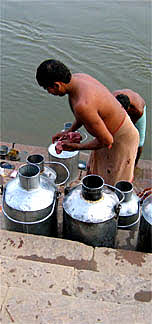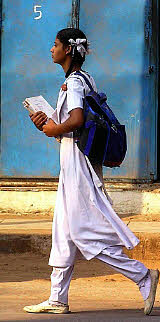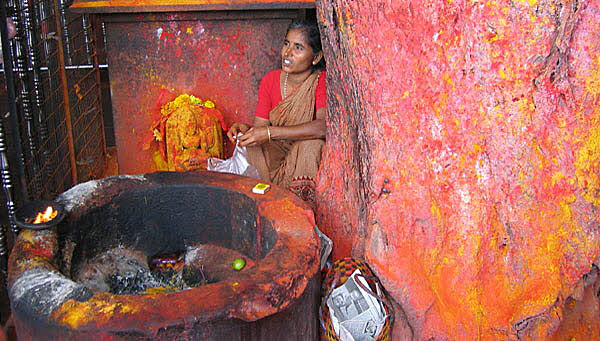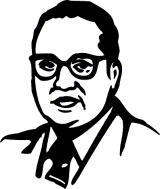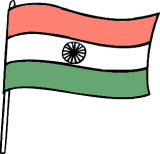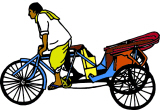start: January 2014
duration: 4 weeks
cost: approximately € 2100
maximum number of participants: 13
itinerary
Chennai
After a flight from Europe, we arrive in Chennai, one of India's
metropolitan cities. We leave the city immediately and drive to the
nearby village of Mamallapuram.
Mamallapuram (3 days)
Mamallapuram is a village inhabited by fishermen and sculptors. It
harbours some of India's first stone (monolithic) temples. At present,
the village is one of the most important suppliers of temple statues in
India. They are produced in numerous open workshops scattered all over
the village. Mamallapuram is also a seaside resort on the backpacker
track. There are small beach restaurants serving grilled fish and shops
selling hip souvenirs from all over India. Given the limited scale of
things and the 'alternative' western influence, you can quietly get
used to the ample presence of India.
On the early morning of our third day in India we leave for Tirupati.
The journey (with a hired bus) takes several hours. On the way we will
stop for a visit to one of the many famous temples of Kanchipuram.
Tirupati (2-3 days)
Tirupati is situated at the foot of the seven wooded hills of Tirumala.
The top of the seventh hill harbours the old Hindu temple of
Venkateshwara, which attracts thousands of pilgrims every day. In
Tirupati you don't see many white faces. The town is completely fixed
up to receive, house and feed its daily streams of believers. In
addition to the Venkateshwara temple (in the hills), there are several
smaller shrines and an old home for wandering ascetics in the town
itself.
On our second day in Tirupati, we take the early morning bus to the
foot of the hills, where we start a 15 km walk to the Venkateshwara
temple. The walk begins with a steep climb and then goes on more
gently, along woods and little shrines. We are accompanied by dozens of
pilgrims. In the vicinity of the temple a complete new town has
emerged. There are banks, hotels, restaurants, parks and lots of shops.
There are also a number of huge barbers' buildings. In the largest one,
near the temple, hundreds of pilgrims (men, women and children) are
tonsured at a time. By offering their hair, they show their humility to
Venkateshwara.
On the third day in Tirupati, we take the morning train to Vijayawada.
We arrive in Vijayawada in the early afternoon.
Vijayawada (7 days)
Vijayawada is an old trading town situated on the banks of the mighty
river Krishna. It is a rich town with a fertile hinterland. Its wealth
is unevenly distributed. The traders in the old town and the big
farmers in the surroundings of the city are rich. At the same time,
Vijayawada is swarmed with cycle rickshaws pedalled around by an army
of poor wretches who were born in the poorer rural areas of Andhra
Pradesh. Some 40% of the local population has to make do with a family
income of less than 50 Euro's a month. There are slums and popular
neighbourhoods all over the place: along the irrigation canals, on the
slopes of the hills and even in the river bed. The old town is a big
labyrinth. Some lanes have a width of barely one metre. This part of
town is the domain of the higher castes: priests and traders. Here, you
can buy anything. Most goods are pushed or pedalled around on heavy
carts. There is no space for cars. There are several old temples, such
as the Shiva temple and the Kanaka Durga temple.
Our hotel is centrally located. The Vijayawada programme includes the
following activities:
- a walk through the old city, including visits to the flower
market, the bathing gaths, the Kanaka Durga temple and the whole sale
parts of the old town. The walk is concluded with a traditional Andhra
meal in a special restaurant.
- a cycle tour, along popular neighbourhoods, a potters'
settlement, irrigation canals and the whole sale fruit market. The tour
closes with a lunch in the boys' village of the aforementioned street
children project.
- a tour across the country side with visits to several
villages, guided by a representative of a local NGO working in the
villages.
- a special day dedicated to SKCV, the street children
project. We visit the head office, the night shelter and the girls'
village. We spend most of the day in the boys' village, which is a more
or less permanent home for 130 street boys.
- a night with Telugu or Hindi film in one of the many local
cinema halls. A typical Indian film concerns a sentimental melodrama
which includes a lot of singing and dancing. Film is the most important
form of popular cultural expression in India by far. Everyone, rich,
poor, young, old goes to the movies and sings and dances along with the
latest film hits.
On our seventh day in Vijayawada we take the early morning
train to Visakhapatnam. We arrive in Visakhapatnam in the early
afternoon.
Visakhapatnam and surroundings (8 days)
Whereas Vijayawada is a typical trade and transport town, Visakhapatnam
is an industrial city. It is one of the most rapidly growing cities of
India. This notwithstanding, the first impression of Visakhapatnam is
that of a relatively spacious and green city. The most important source
and starting point of uban and industrial growth was a natural sea
port. At present, Visakhaptnam is the second port of India.
Visakhapatnam is a conglomerate of villages. The historical centre is
formed by an old fishermen's settlement surrounded by a great number of
densely populated caste bound popular settlements. It is a chaotic
complex of buildings and huts situated along narrow, winding lanes and
small squares. The city is surrounded by tropical hills bordered by the
sandy beaches
of the Bay of Bengal. Immediately north of the city there is an
important Hindu temple dedicated to the half-man-half-lion incarnation
of Vishnu, Narasimha Swami. Further inland there is a rather isolated
mountainous area, inhabited by a tribal population.
We stay in a lively, centrally located hotel which is known for its
superb South Indian meals. We start our Visakhapatnam programme outside
the city with a two day stay in the quietness of Rushikonda, a hill on
the beach. Our hotel is situated on the slope of the hill and offers a
wide panorama of the mostly empty beach and the Bay of Bengal. What
remains are the following activities:
- a three day tour to Araku Valley, situated high up in the
mountains near the Orissa border. On the way to Araku we pay a visit to
a village of coppersmiths, a (cane) sugar factory and some coffee and
pepper plantations. In Araku, we stay in a simple hotel with a view of
the valley. During our stay we visit a tribal market and an NGO working
through and for the local tribal population.
- a visit to a 17th century Dutch trading post, including a
cemetery.
a walk through the old parts of town, including a visit to a dargha
(the grave of a local Muslim saint), the central fishermen settlement,
other densely built, caste bound settlements and the colonial office of
the collector.
On the seventh day of our stay in Visakhapatnam, we take the evening
train to Puri (Orissa). We arrive in Puri next morning.
Puri (3 days)
Just like the Venkateshwara temple in Tirupati,
the Jaganath temple of Puri is an important object of Hindu pilgrimage.
Apart from large groups of pilgrims from all over India, the temple
also attracts complete armies of monkeys. In addition to a pilgrimage
centre, Puri is a typical Indian sea side resort, attracting lots of
tourists from nearby Kolkata. To conclude, Puri harbours a separate
Western tourist quarter, situated at the fringe of the town, near a
large fishermen settlement. We can organise various excursions, e.g. to
the famous Sun temple of Konark. A temple fanatic could consider a
visit to the beautiful temples of Bubaneshwar. On our third day in Puri
we take the evening train to Kolkata. We arrive in Kolkata next
morning.
Kolkata (3 days)
Kolkata (Calcutta) is supposed to be the most chaotic and miserable
city of India. At the same time it is the cultural capital of India.
Everything beautiful and squalid in India, can be found in its most
concentrated form in Kolkata. Once it was the capital British India, a
rich trading centre and a melting pot of cultures. The city is full of
the remains of its glorious past: colonial buildings, trading houses,
palaces, grand villa's, churches, synagogues, temples and mosques.
Since its heyday the city has grown tremendously. At the same time it
declined and deteriorated. We offer a number of walks that show the
most beautiful spots of the city. On the night of our third day in
Kolkata we fly back to Amsterdam.


